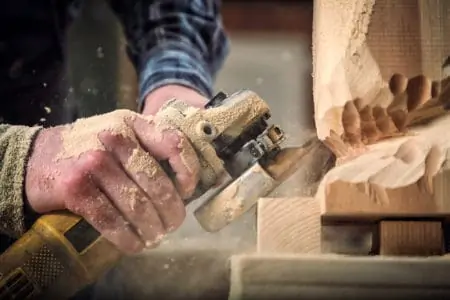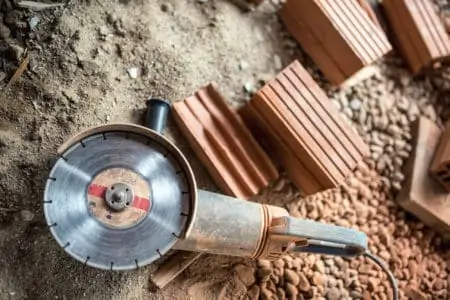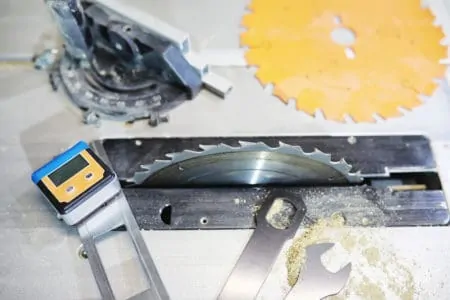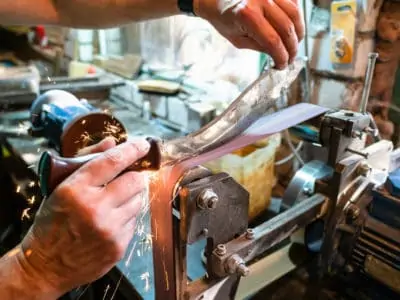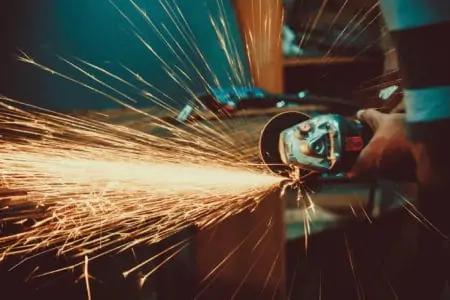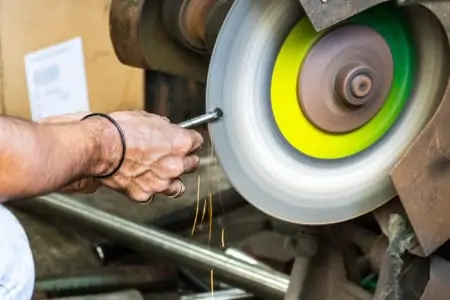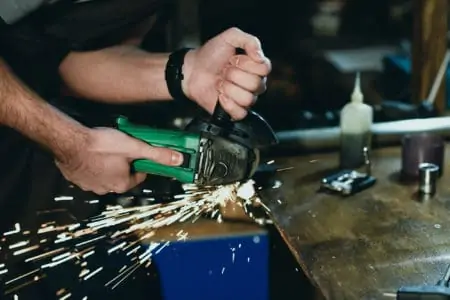Angle grinders are versatile tools that sand, grind, polish, and even cut through brickwork and stone. But how good are they at cutting through wood? We conducted extensive research to find out the answer to this question. We also offer tips and hints to improve your technique.
Can angle grinders cut wood? Let’s find out.
Key Takeaways
- Angle grinders can cut wood, but it’s not ideal. Use a 4 or 5-inch wood carving and cutting disc for better results.
- Wood cutting with an angle grinder is risky and may result in a messy finish. Use a miter or circular saw for more accurate cuts.
- When using an angle grinder to cut wood, always wear safety gear, clamp the wood securely, and keep a firm grip on the tool with two hands.
- Remember to follow safety tips, such as pointing the grinder away from you and taking breaks to let the wood cool down to prevent combustion.
Can Angle Grinders Cut Wood?
The first question to ask is, why would you want to? If you own an angle grinder, there’s a fair chance you own a saw. So, use the saw to cut the wood and keep the angle grinder for cutting masonry, concrete, and other harder materials.
If, by some miracle of fate, you have lost your saw and have no alternative, then yes, an angle grinder will slice through wood. But it’s not without its risks.
You need to choose the right cutting disc. You could use your metal cutting disc, and that will get the job done, but it isn’t ideal because it’s an abrasive grinder that could cause combustion through excessive heat build-up.
So, if you are using a metal cutting disc, remember to work slowly and always pause to allow the material to cool down. Plus, you would only be able to cut thinner pieces of wood with this type of disc.
What Attachment Should I Use?
You will need a 4 or 5-inch wood carving and cutting disc to cut wood with an angle grinder. For most wood-cutting applications, a 4.5-inch wood-cutting disc will do just fine. If you want to slice through logs, you’ll need a bigger angle grinder.
These discs have 3 teeth rather than the many teeth found on crosscut and ripping blades. When you match the blade rotation with the speed of your grinder, it will cut wood easily.
Whichever attachment you use, the resulting cut will be of inferior quality. It won’t match the neatness you get from a circular saw or handsaw, but it will work.
You might also need to change your cutting position slightly to compensate for the material. The danger with this is that the grinder could suddenly alter course without you realizing it, which means you would need lightning-fast reactions to stop the grinder from spinning out of control.
An out-of-control angle grinder spinning at 15,000 RPM (revolutions per minute) is not an ideal situation. Your journey home doesn’t need to include a trip to the emergency room!
What Is the Best Tool To Cut Wood?
Miter saws and circular saws are the best tools for cutting wood. They operate at a reduced RPM of 5,000, compared to 10,000 to 15,000 RPM for angle grinders, but wood is a much more forgiving material than brick and stone.
You could reach for the handsaw, but this will slow your progress. When time is money, the faster you work, the better. Here’s a list of the best tools you can use to cut wood:
- Table saw.
- Router.
- Jigsaw.
- Hacksaw.
- Coping saw.
- Bowsaw.
- Crosscut saw.
- Pruning saw.
- Rip cut saw.
- Chainsaw.
How Do You Cut Wood With an Angle Grinder?
Here’s a list of the tools you will need:
- Measuring tape and pencil.
- Dust mask or respirator.
- Safety glasses.
- Ruler.
- Gloves.
- Angle grinder.
- Wrench.
- Wood-cutting angle grinder disc.
Before we begin, understand that angle grinders are not straight cutting tools in the same way that a table saw, or a miter saw are. They don’t have fences or guide tracks. You are relying on your skill with the tool to complete an accurate cut.
1. Put on Your Safety Gear
Before attempting anything, protect yourself with goggles, a face mask, and gloves. It helps to avoid any injuries that could see you visiting the emergency room. Also, make sure the angle grinder is not plugged in.
2. Clamp the Wood
If your work table has a clamp or grip to hold the wood in place, it’s best to use it. The last thing you want is for your project to start sliding around. If it does, you are no longer in control of the grinder or the workpiece.
If you don’t have a clamp, you can buy clamps cheaply enough from the hardware store.
3. Adjust the Disc Guard
Angle grinders have a half-disc guard covering the blade, which you can adjust to act as a shield to protect your hand while cutting.
Rotate the guard and then press the switch near the blade to lock the guard into position.
4. Measure and Mark
Decide which side of the material you want to cut, and then grab the tape measure and the pencil. You won’t get a straight cut without accurate measurements. When you decide where you want to make the cut, use the ruler to mark the line.
5. Install the Wood Cutting Disc
If you have a disc installed in the grinder, you will have to remove it. Press the spindle lock switch to stop the old blade from moving, and grab the wrench to loosen the clamping nut. Now you can swap the blades.
Place the pointed side of the clamping flange on the disc, making sure that the flat side faces outward. This is because you are swapping a thinner disc with a fatter one.
Screw the flange tightly, ensuring that the disc points the same way as the tool spins. If you are not sure, check the directions of the arrows on the disc.
6. Power Up
Plug the grinder in and switch it on. If you have a cordless model, insert the battery and press the on switch.
7. Make the Cut
Using the marked line as your guide, press the trigger button, and the disc will start spinning. It doesn’t matter which end of the cut-line you start at; just keep the grinder in a firm grip, as it will move around.
Press the disc into the wood and move the grinder back and forth as it makes the cut.
Angle Grinder Safety Tips
When you are using any type of power tool, there are safe ways to handle them. So, what tips do we have to keep you injury-free? Here are a few you might like.
Point the Grinder Away
Whenever you switch on the grinder, make sure the blade is facing away from you. Remember that you have adjusted the blade-guard so it is exposed. Keep it away from your hands and wrists or it could spell disaster.
Think Safety at All Times
Never let your guard drop when it comes to safety. Always take the cautious approach and put on your goggles, gloves and dust mask. Sawdust is highly toxic, and it could lead to serious lung conditions like cancer and if inhaled.
The goggles will stop any flying debris from lodging in your eyes, and the gloves keep your hands as safe as possible from the blade.
Hold the Grinder With Two Hands
Grinders are powerful machines, spinning in excess of 10,000 RPM. Don’t be fooled by the lightweight design of the tool. You might think you can use it with one hand, but you will need two hands to control it when it starts to bite into the wood.
It also makes it easier to follow the cut-line, resulting in a neater finish.
Keep Your Distance
Don’t stand so close to the cutting area. Remember that the guard is locked open, so the blade is always exposed, and if you get a kickback, you don’t want to be too close.
Clamp the Wood
Controlling the angle grinder is hard enough without making your life even more complicated. The wood needs to be firmly secured to the work table before you start. That way, you are only fighting one battle instead of two.
Cut Wood With an Angle Grinder or Not?
Ask the professionals, and they’ll tell you that angle grinders are excellent grinding, polishing, and shaping tools, but when it comes to cutting wood, stick to a power saw. Grinders are hard to control, leave a messy finish, and above all else, dangerous, especially when it comes to fire risks.
If you still want to attempt it, use the guide above, but otherwise, use a saw.
